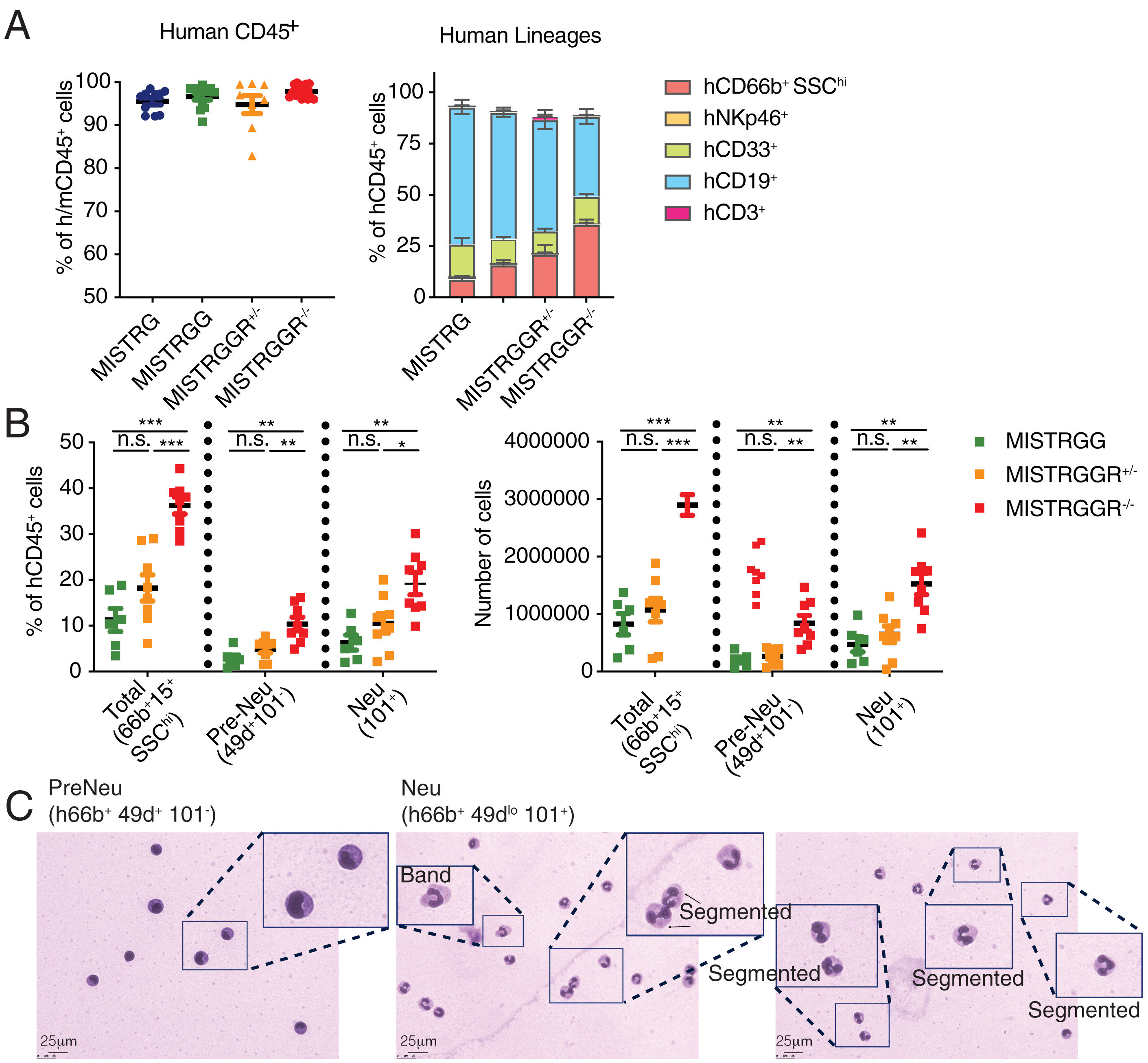
A new mouse model provides an unprecedented view of the human immune system
Improved bone marrow granulopoiesis in MISTRGGR mice. Bone marrow cells were analyzed 8 weeks after transplantation. (A) Frequencies of human hematopoietic cells (hCD45+) (Left) (MISTRG, n = 10; MISTRGG, n = 12; MISTRGGR+/−, n = 8; MISTRGGR−/−n = 15 mice), human lines (right) (MISTRG, n = 5; MISTRGG, n = 12; MISTRGGR+/−, n = 8; MISTRGGR−/−, n = 8 mice). Data from three independent experiments. (B) Frequency (left) and number (right) of human neutrophils (hCD66b+ SSChi), Pre-Neu (hCD49d+ CD101–), and Neu (hCD101+) in bone marrow MISTRGG (n = 6 mice), MISTRGGR+/− (n = 8 mice), and MISTRGGR−/− (n = 8 mice). Data combined from at least two independent experiments. (C) MGG staining of sorted Pre-Neu (left) and Neu (center and right) bone marrow cells. Enlarged frames highlight different stages of development of human neutrophils. (A and B) Data are shown as mean ± SEM. P values are determined using the two-tailed Mann-Whitney test (*P Proceedings of the National Academy of Sciences (2022). DOI: 10.1073/pnas.2121077119
When a finger is pricked or a knee is scratched, neutrophils rush to the scene. These white blood cells are the first line of defense against infection in all multicellular organisms. “They are absolutely necessary for life,” says Richard Flavell, Ph.D., professor of immunobiology at Yale School of Medicine.
Humanized mouse models, or mice engineered for a functional human immune system, are a valuable tool for scientists to observe immunobiology in action, but they have limitations. Despite the important role of neutrophils, no one has been able to study them in a living context. But now a group of Yale researchers led by Flavell have developed the first humanized mouse model which will allow scientists to study neutrophils in vivo. The team published their results in PNAS October 21.
“Neutrophils are involved in virtually all immunological diseases,” says Essen Sefik, Ph.D., researcher and project associate. “Our new model will open up many opportunities for a number of scientists studying various diseases.”
To create a humanized mouse model, researchers transfer progenitor cells into an animal that creates a human immune system that can mimic what would happen in the human body in the presence of pathogens. But in previous mouse models, human neutrophils could not grow because they were crowded out by pre-existing mouse neutrophils.
Functioning human neutrophils in living animals
Granulocyte colony-stimulating factor (G-CSF) is a cytokine that promotes the growth and circulation of neutrophils. The binding of G-CSF to its receptor, known as G-CSFR, stimulates this proliferation. In their new mouse model, the team humanized the cytokine G-CSF for the first time. However, they quickly realized that this was not enough – mouse neutrophils continued to dominate. They then removed the murine G-CSF receptors and found that this significantly reduced the number of murine neutrophils in the circulation and in the bone marrow.
“We realized that mouse neutrophils still detect and respond to human cytokines,” Sefik says. “So we put these neutrophils at a disadvantage by knocking out the receptor in the mouse cells that responds to G-CSF, thus creating a deficit mouse neutrophils and allows only human neutrophils to respond to G-CSF.”
With this discovery, the team wanted to make sure that human neutrophils function in an intact state. They looked at their ability to respond to chemokines and express chemokine receptors, measured neutrophil production active forms of oxygen, and studied their ability to create extracellular traps to capture inflammatory targets. “One by one, we looked at what neutrophils are supposed to do and confirmed that they function in a steady state,” Sefik says.
Next, the team tested the ability of human neutrophils to respond to inflammation. They induced inflammation in the lungs using aerosolized lipopolysaccharide (LPS), a component of some bacteria that can cause an acute inflammatory response in tissues, and they found that in response, neutrophils migrated to the lungs. They then tested the response of neutrophils to an active infection by injecting Pseudomonas aeruginosa, a bacterium that mainly affects immunocompromised people and is a major cause of hospital-acquired pneumonia. They found that neutrophils are able to fight infection. “We showed that they have the ability to kill bacteria, which is a very important function of neutrophils,” Sefik says.
Finally, the team tested whether neutrophils can mobilize to other parts of the body. They induced inflammation in the skin of mice and found that neutrophils mobilized there within minutes. “This shows that our findings were not just a lung phenomenon and that neutrophils can be home to any tissue,” Sefik says.
Neutrophils in COVID, cancer and more
The team is not only excited about their scientific achievements, but also their ability to work together to overcome the many obstacles that have arisen due to COVID, including the time when COVID health protocols kept them out of the lab. “This is not only good science, but it’s an example of science done in a very challenging pandemic environment,” says Flavell. “The victory here is not just about the science, but about getting the job done under these extremely challenging conditions. That’s an achievement in itself.”
Flavell’s new humanized mice are an unprecedented way to model human neutrophils in the living organism. The researchers hope that their work will lead to a better understanding of these critical things leukocytes and their role in a wide variety of diseases. In future studies, the team hopes to examine neutrophils in the context of COVID and learn more about how they may contribute to SARS-CoV-2 pathology. They also hope to learn more about the cells’ role in cancer by placing tumors in their humanized mouse models and studying neutrophils‘ the answer.
Yunjiang Zheng et al. Development and functionality of human neutrophils incorporated into a humanized mouse model, Proceedings of the National Academy of Sciences (2022). DOI: 10.1073/pnas.2121077119
Provided
Yale University
Citation: New mouse model provides unprecedented insight into human immune system (October 25, 2022) Retrieved October 25, 2022 from https://medicalxpress.com/news/2022-10-mouse-unprecedented-human-immune.html
This document is subject to copyright. Except in good faith for the purpose of private study or research, no part may be reproduced without written permission. The content is provided for informational purposes only.


